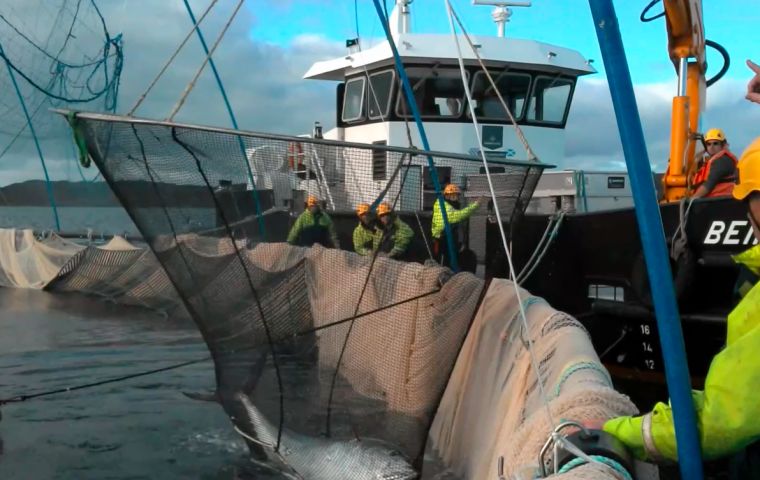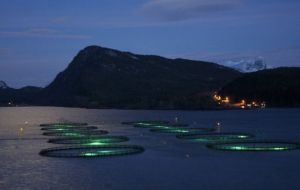MercoPress. South Atlantic News Agency
Using AI to improve salmon farming: correct feeding times and elimination of lice
 According to Lingalaks fish farms in Norway, which produce nearly three million salmon each year, the fish make less noise once the feeding frenzy is over.
According to Lingalaks fish farms in Norway, which produce nearly three million salmon each year, the fish make less noise once the feeding frenzy is over.  A new hydro-acoustic system listens salmon sloshing loudly about as they feed in a cluster. When the fish have had enough, they swim off and the noise lessens.
A new hydro-acoustic system listens salmon sloshing loudly about as they feed in a cluster. When the fish have had enough, they swim off and the noise lessens. Fish farming is big business - the industry now produces about 100 million tons a year, and with salmon prices soaring, producers are turning to lasers, automation and artificial intelligence to boost production and cut costs. How do you know if farmed salmon have had enough to eat?
Well, according to Lingalaks fish farms in Norway, which produce nearly three million salmon each year, the fish make less noise once the feeding frenzy is over.
The firm knows this thanks to a new hydro-acoustic system it has installed at one of its farms. The system listens to the salmon sloshing loudly about as they feed in a cluster. When the fish have had enough, they swim off and the noise lessens.
Lingalaks chief executive Erlend Haugarvoll hopes this knowledge will save his firm lots of money in reduced feed, as much of it currently gets wasted.
“I think it could improve [expenditure] by about 5%,” he says. ”That could be between 7m-10m krone (US$900,000-US$1.3m) for our firm.“
”It's not like a pellet detector,“ Mr Sovegjarto says, which observes the number of fish food pellets left in the water. ”When you don't see any pellets, you can't be certain if it's because the fish are full or that you're looking in the wrong place because of the water currents.”
Using audio data from the caged salmon is more accurate and could save Norwegian fish farms 1bn krone (US$ 130m) a year in un-gobbled feed, believes Mr Sovegjarto.
The technology has been developed with the help of Ole Folkedal, at The Institute of Marine Research, in Bergen. He has monitored salmon feeding patterns and other data, such as water temperature and oxygen levels, and this is giving scientists and farmers new insights into the factors influencing how much the fish want to eat.
“You have huge variations in how much to feed every day,” says Mr Folkedal. He adds that the data can be used to operate completely automated feeding systems, with humans simply overseeing the process. The rise of artificial intelligence technologies like these, which make decisions about when feeding should stop and start, is set to make big changes to the lucrative industry of salmon farming.
There are other hi-tech approaches to automated fish monitoring, too.
For example, one start-up, Aquabyte, recently raised US$3.5m for a system that makes better use of existing video surveillance data. Many modern fish farms already use video cameras to monitor the salmon in their cages, says Aquabyte founder and chief executive Bryton Shang.
“They stick CCTV in the pens and have operators off site watching the fish and determining how much to feed,” he explains. “We take the images from the CCTV and use computer vision algorithms [instead].”
With this approach, computers carefully monitor the group of feeding fish visually. The system is also designed to look out for a perennially problematic visitor to fish farms - the parasitic sea louse.
Lice attach to salmon and eat them, causing damage that can be fatal. The lice can also make the fish inedible for humans. Mr Shang hopes his technology will help farmers detect sea lice so that they can then be removed manually.
But even lice removal could be automated in the future. Stingray has come up with a self-guided tool that fires lasers at the lice to destroy them.
The louse is hit with a fatal result, and coagulates within milliseconds,” boasts the company's website. Meanwhile the de-loused salmon, thanks to its mirror-like skin that reflects the laser, swims off unharmed.
It's perhaps no surprise that salmon farmers are turning to hi-tech solutions - the industry is certainly a wealthy one.
Fish farms are worth US$6.4bn to the Norwegian economy, and this year the country is expected to see growth of 9% in a farmed salmon production.
Norwegian fish company Salmar's gigantic offshore installation, Ocean Farm 1, is a 110m-wide (120 yards) cage capable of containing 1.5 million fish.
London-based Hemang Rishi, co-founder of Observe Technologies, says his firm is developing technology that can visually monitor feeding in salmon cages.
“We are just deploying our first product on site for an extended period of time in Chile, where they have the second largest salmon market in the world after Norway,” he says.
And in Florida, a firm called Atlantic Sapphire is hoping to construct a giant salmon farm - on land. The concept involves water swirled mechanically in large tanks to give fish the illusion that they are still at sea. It's not hard to imagine highly automated fish farms of the future, in which humans have very little to do.
“My prediction is that autonomous systems will do most of the jobs in future years,” says Mr Folkedal.
However, he notes that current regulations in Norway mean that, for now at least, farmed fish must be manually checked regularly for signs of illness and mortalities.
But many of the tasks farmers must perform daily - such as counting and measuring fish are tedious, and could be automated once machines become accurate enough, Mr Folkedal believes. “That's something that the farmers really want,” he says. (BBC).




Top Comments
Disclaimer & comment rulesCommenting for this story is now closed.
If you have a Facebook account, become a fan and comment on our Facebook Page!